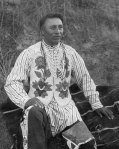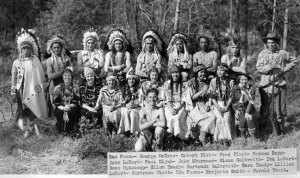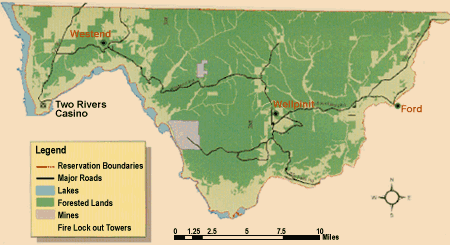Spokane Indian Tribe
SPOKANE INDIAN TRIBE
The Spokane Indians should be considered a culture because it is a group of people who have shared beliefs, values, language, and experiences.
Click to play a traditional Spokane Indian dance song:
Food
The Spokane Indians had a variety of food that they gathered from their surroundings. The most important vegetable that they gathered was the camas root. This is a lily, and the Indians would cook it like we cook potatoes (mashed, in stews etc). Another vegetable was the cattail shoot which was eaten raw or cooked. Wild carrots were used to season stews and venison as were wild onions. For dessert the Indians would boil and press black moss. This supposedly tasted like licorice. They also made wild peppermint tea. For protein they found eggs of swans, wild geese, ducks, brant and tooloo. They also hunted for deer, bear rabbits, grouse, ducks, geese and beaver. In the rivers they fished for salmon, link cod and devilfish (The Wellpinit School District, 2010).
Dress and Appearance
Traditional dress of Spokane Indians included breechcloths (a long rectangular piece of hide or cloth tucked over a belt, so the flaps fell down in the front and back) and leggings for men, while women wore skirts, or one-piece dresses, and leggings. During the winter months men and women would use cloaks, or fur parkas to stay warm. Universal among Native American dress is some form of moccasin (a sturdy leather shoe) which still remains popular today. Currently, many Spokane Indians wear traditional clothing, called regalia, only during ceremonial occasions. Contemporary clothing includes shirts with native designs and jeans for everyday weal (Wellpinit School District, 2010).
Language
Spokane Indians identify with the Salish language, a language also used by the neighboring tribes of the Kalispel and Flathead. Currently, there are a little over 200 Salish speakers most of whom are elders. Although it is an endangered language, there are those who are working to preserve this vital part of their culture (Native Languages of the Americas, 2009). The use of the Salish language extends from Montana to Washington. It includes its own comprehensive alphabet. The main way for communicating important information is through oral stories and songs. In addition, this is how history, living and culture is passed down to the younger generation (Spokane Tribe of Indians Language Program).
Alphabet http://spokanelanguage.com/AlphabetMoviePage.htm
Songs http://spokanelanguage.com/Hello_songMoviePage.htm
Stories http://spokanelanguage.com/BrownBearMoviePage.htm
Learning
In regards to learning, many of the Spokane Indians choose to attend the Wellpinit School District that includes grades k-12. The Wellpinit School District is located on the Spokane Indian reservation in Wellpinit, WA (about an hour and half from Spokane). The curriculum follows the state of Washington’s education standards while incorporating and providing a focus on the Spokane Indian culture (The Wellpinit School, 2010). As mentioned previously, the Spokane Indians are very song, story and poem oriented in regards to relaying information. They are a crucial part of the culture that must not be overlooked (Spokane tribe of Indians Language Program).
http://www.wellpinit.wednet.edu/home/home.php
Work Habits and Practices
Mining and logging companies employ many residents of the Wellpinit Reservation. Other common jobs are in the farming and livestock industries. Tribal members tend to be reliable and hardworking. Timber sales are the largest contributor to tribal income, and the acquisition of land is important to tribal identity.
Relationships/Social Organization
Traditionally, kinships were based on the marriage of a man and woman; however, it was permitted for a man to have more than one wife (polygyny), but this was not common practice among tribal members. Children lived with their parents and the nuclear family retained close relationships with both the mother and father’s families. Female cousin were called by the same terms as those used for sisters; thus, preventing marriage among first cousins. Social activities and gatherings were based on the changing seasons and available resources. In the spring camps were dispersed into smaller groups to gather food, hunt and fish. The main activities for the tribe in the summer included salmon fishing, hunting and root digging. During fall neighboring tribes would join together to gather berries and dig for roots. The tradition of socializing with other tribes is carried on today with the Indian Powwow which begins in June and ends in September. The contemporary family structure remains similar to past family organization; that is, families are extended and often include mothers, father, grandparents, aunts, uncles, and cousins all living in very close proximity to one another (Wellpinit School District, 2010).
http://www.nasponline.org/publications/cq/cq328native.aspx
Traditions
One tradition that the Spokane Indian tribe had was called the Salmon Ceremony. This was held the first four days of the salmon run. Only men were invited to the ceremony, and the first catch of salmon would be cut the day they caught it. One chosen man would cut the salmon into seven pieces and then it was cooked a special way. All of the salmon caught these first four days had to be eaten by men. Legend had it that if they kept this ritual, the salmon would keep coming every year (The Wellpinit School District, 2010).
Beliefs and Attitudes
Many Spokane Indian Tribal Members belong to the Protestant or Catholic religions. Others intermingle Christianity with traditional beliefs. Traditional beliefs include the belief in Amotkan, who is associated with the sun and is thought to be the giver of life. He is also thought to be a bearded white man. The Black One is Amotkan’s counterpart and is considered to be evil. The Spokane also believe that animals can become guardians of humans. The Winter Spirit Dance is the considered the most important of the ceremonies and is where humans interact with their animal guardians. The use of medicine men is also employed, and they are viewed as healers and advisors (Ruby & Brown, 1970).
Cultural Taboos
The Spokane Indians believe that after death every part of the body must be buried with the body to prevent the soul from becoming a ghost. This includes any blood that may have been spilt. It is custom to use a cloth to wipe up any blood and to bury the cloth with the body. This belief prevents the Spokane from organ donation. This also becomes an issue when parts of the body may be removed for testing after death (Ross, 2008).
The impact this has on health care is important. Because organ donation is shunned, there are very few organs available for recipients in this culture. It is also important to know that if a surgery is performed for the removal of an organ such as the gallbladder that the patient might request to have the gallbladder returned to them after the surgery. It may also be something that can be offered to convince a patient to have a needed surgery.
Values
The Spokane Indians are very passionate about their heritage. They continue to study and practice many values that their ancestors did. For example, they still believe that family is a nuclear family and includes closest relatives from both sides. They also have no traditional holidays, but practice rituals throughout the year. Their history and traditions continue to be taught to their children in the Wellpinit School District (Wellpinit School District, 2010).
They also work diligently to protect what is left of their historical lands. Visitors to their land at Lake Roosevelt have destroyed and taken from archeological sites and they are working hard to get the word out that they value this land and it is their only link with their cultural heritage (Spokane Tribe of Indians, Cultural Preservation, 2010).
Health
Health care workers should be aware of the many plants that Spokane Indian Tribe has traditionally used for medicinal purposes (Wellpinit School District, 2010):
Cascara bark: Laxative
Marijuana: Anesthetic
Kenghentia: Healing Agent
Enghanchanson: Toothache
Basalm Oil: Blisters
Basalm Tea: Cough Syrup
Bath with Basalm Branches: Aching Joints
Elderberry Leaves: Infections
Red Willow Bark: Eye Infections
There are many health risk behaviors prevalent among the Native American population. Native Americans have been shown to have a high rate of binge drinking, including pregnant women. They are 3 to 4 times more likely to use alcohol during pregnancy than the general population (Castor, Smyser, Taualii, Park, Lawson, & Forquera, 2006). They also reported a higher use of tobacco and a lower rate of physical activity than any other major racial or ethnic group (Denny & Holtzman, 2003). What is interesting about their tobacco usage is that even though a significant number desire to quit their health care providers treat it as a low priority and are hesitant to support their decision (Lando, Johnson, Graham-Tomasi, McGovern, & Solberg, 1992). This, among so other access issues, suggests that there may be health care discrimination problem.
These behaviors may lead to the higher rates of certain diseases and mortality may be associated with these high risk behaviors. American Indians are more likely to have premature babies and have a higher rate of infant mortality (Castor et al, 2006). They have a higher rate of diabetes and obesity than other racial or ethnic groups (Denny & Holtzman, 2003). On top of these high prevalence of these health issues, their mortality rate due to chronic liver disease/cirrhosis, diabetes, and alcohol use exceeds that of the general population (Castor et al, 2006).
Obtaining health care has also been a constant issue for American Indians. They tend to use health care clinics less often than the general population. This includes health care for general check-ups and prenatal care (Castor et al, 2006; Denny & Holtzman, 2003). This may be attributed to less frequent insurance coverage or their higher poverty rate (Castor et al, 2006).
Other issues that play an important role in health care has to do with local industries. Mining in the area of the Spokane Indian Tribe is not uncommon and has provided much needed jobs and financial support for many of the people. However certain types of mining, such as uranium, have been done and are currently causing problems for these native people and often goes overlooked (Harper, Flett, Harris, Abeyta, & Kirschner 2002). Some of the tribe members have started a group called SHAWL Society that serves as a public awareness and advocacy group. For more information visit their website: http//shawlsociety.blogspot.com/
Uranium Mining Video:
Demographics and Statistics
(provided by http://www.city-data.com/city/Spokane-Reservation-Washington.html)
Population: 2,081 (July 2007)
Breakdown:
- American Indian (76.5%)
- White Non-Hispanic (18.5%)
- Hispanic (4.3%)
- Two or more races (3.7%)
Average Income vs Washington State: $37,255 (2008) vs $58,078 (2008)
Percentage below poverty level vs Washington State: 28.7% vs 10.6%
Education:
Top 5 Things Nurses Should Know:
- Burial Practices
- Uranium Mine Affects
- Smoking Use
- Alcohol Use
- Under Utilization of Health Care Service
References
Castor, M. L., Smyser, M. S., Taualii, M. M., Park, A. N., Lawson, S. A., & Forquera,R.A. (2006). A Nationwide Population-Based Study Identifying Health Disparities Between American Indians/Alaska Nativesand the General Populations Living in Select Urban Counties. American Journal of Public Health, 96, 1478-1484.
Denny, C. H., Holtzman, D.. Cobb, N. (2003). Surveillance for Health Behaviors of American Indians and Alaska NativesFindings from the Behavioral Risk Factor Surveillance System, 1997–2000. Surveillance Summaries, 52, 1-13.
Harper, B.L., Flett, B., Harris, S., Abeyta, C., Kirschner, F. (2002). The Spokane Tribe’s Mutipathway Subsistance Exposure Scenario Level RME. Society for Risk Analysis, vol 22(3), 2002, 513-526.
Lando, H.A., Johnson, K.M., Graham-Tomasi, R.P., McGovern, P.G., Solberg, L. (1992). Urban Indians’ Smoking Patterns and Interest in Quitting. Public Health Reports, vol. 107 (3), 340-344.
Native Languages of the Americas, Initials. (2009). Native Languages of the Americas. Retrieved from http://www.native-languages.org/salish.htm
Puukka, L. E., Stehr-Green, P., & Becker, T. M. (2005). Measuring the Health Status Gap for American Indians/Alaska Natives: Getting Closer to the Truth. American Journal of Public Health, 95, 838-843.
Ross, John Alan. “Spokane Burial Rituals and Associated Mortuary Beliefs.” Journal ofNorthwest Anthropology V 42.1 (2008): 17-70. First Search. Anthropology Plus.
Amherst Library, Amherst, MA. 15 March 2009.<http://firstsearch.oclc.org/WebZ/FSFETCH?fetchtype=fsapp4-41300>.
Ruby, Robert H., and John A. Brown. The Spokane Indians, Children of the Sun. Norman: University of Oklahoma Press, 1970. Spokane Tribe of Indians Language Program. (n.d.). Retrieved from http://spokanelanguage.com
Spokane Tribe of Indians (2010). Protecting and Respecting Cultural Resources. Retrieved from http://www.spokanetribe.com/page.php?code=culture.
The Wellpinit School District (2010). Retrieved from http://www.wellpinit.wednet.edu/district/visionstatement.php






Leave a comment